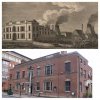Brasshaire Porrage Birmingham, Bras SH Porrage Bham, and Brass H. Porrage.
As a retired journalist, it has belatedly occurred to me, in my dotage, that I know more about the life of many another than I do of my own. Accordingly, I recently decided to indulge in amateur genealogy. With the emphasis on amateur. Knowing nothing about how best to proceed, I took out a temporary subscription to a specialist website so as to facilitate access to records relating to family members long gone, most notably, my parents.
I've now come to appreciate why so many find this kind of research so absorbing.
I knew I was, if not a Son of Birmingham, then certainly, a Grandson. What I hadn't realised was the extent to which I am infused with Scottish blood. Or at the very least, some strain of Scott's Porage Oats.
The revelation came about thanks to the transcript of 1911 census data relating to my father's Birmingham childhood. The transcript reports that he and his brothers and sisters were born variously at Brasshaire Porrage Birmingham, Bras SH Porrage Bham, and Brass H. Porrage.
Ah. Put not your faith in OCR.
A check on the original data, and also that from 1901, provided enlightenment. My father was born in Brasshouse Passage. One hundred and fourteen years ago next week.
I gather from today's street maps that neither Brasshaire Porrage nor Brasshouse Passage exist. This was confirmed by a Google search, which happily led to this forum, and explains why I'm here and pestering folks.
What I'm trying to develop is some idea of what and where that address actually was. I've been fortunate enough to access some old maps, but not one of them has specifically identified the location. Though most of the maps don't have street names, thankfully, an 1899 version does, an enlarged section of which I include here:

Reason for choosing that particular section is that one of my Google searches led to a post on this forum of some years ago in which the poster said he thought Brasshouse Passage ran from (or to) King Alfred's Place or, alternatively, King Edward's Place. Looking at the map though, I can see no evidence of that. There is, however, some kind of through access betwixt Broad Street and Cambridge Street. Unfortunately, the map makes no mention of Passage, still less of Hairy Porridge.
Help would therefore be much be appreciated; I clicked on some thumbnails yesterday which I thought might possibly be of relevance but unfortunately the images failed to open -- hence why I'm troubling everyone today.
As a retired journalist, it has belatedly occurred to me, in my dotage, that I know more about the life of many another than I do of my own. Accordingly, I recently decided to indulge in amateur genealogy. With the emphasis on amateur. Knowing nothing about how best to proceed, I took out a temporary subscription to a specialist website so as to facilitate access to records relating to family members long gone, most notably, my parents.
I've now come to appreciate why so many find this kind of research so absorbing.
I knew I was, if not a Son of Birmingham, then certainly, a Grandson. What I hadn't realised was the extent to which I am infused with Scottish blood. Or at the very least, some strain of Scott's Porage Oats.
The revelation came about thanks to the transcript of 1911 census data relating to my father's Birmingham childhood. The transcript reports that he and his brothers and sisters were born variously at Brasshaire Porrage Birmingham, Bras SH Porrage Bham, and Brass H. Porrage.
Ah. Put not your faith in OCR.
A check on the original data, and also that from 1901, provided enlightenment. My father was born in Brasshouse Passage. One hundred and fourteen years ago next week.
I gather from today's street maps that neither Brasshaire Porrage nor Brasshouse Passage exist. This was confirmed by a Google search, which happily led to this forum, and explains why I'm here and pestering folks.
What I'm trying to develop is some idea of what and where that address actually was. I've been fortunate enough to access some old maps, but not one of them has specifically identified the location. Though most of the maps don't have street names, thankfully, an 1899 version does, an enlarged section of which I include here:

Reason for choosing that particular section is that one of my Google searches led to a post on this forum of some years ago in which the poster said he thought Brasshouse Passage ran from (or to) King Alfred's Place or, alternatively, King Edward's Place. Looking at the map though, I can see no evidence of that. There is, however, some kind of through access betwixt Broad Street and Cambridge Street. Unfortunately, the map makes no mention of Passage, still less of Hairy Porridge.
Help would therefore be much be appreciated; I clicked on some thumbnails yesterday which I thought might possibly be of relevance but unfortunately the images failed to open -- hence why I'm troubling everyone today.






